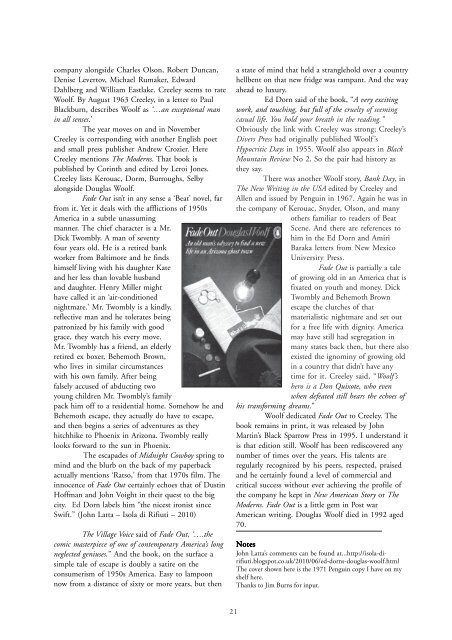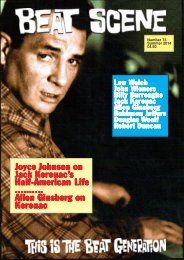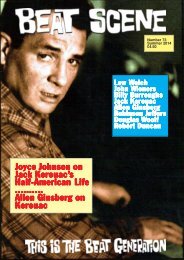You also want an ePaper? Increase the reach of your titles
YUMPU automatically turns print PDFs into web optimized ePapers that Google loves.
company alongside Charles Olson, Robert Duncan,<br />
Denise Levertov, Michael Rumaker, Edward<br />
Dahlberg and William Eastlake. Creeley seems to rate<br />
Woolf. By August 1963 Creeley, in a letter to Paul<br />
Blackburn, describes Woolf as ‘…an exceptional man<br />
in all senses.’<br />
The year moves on and in November<br />
Creeley is corresponding with another English poet<br />
and small press publisher Andrew Crozier. Here<br />
Creeley mentions The Moderns. That book is<br />
published by Corinth and edited by Leroi Jones.<br />
Creeley lists Kerouac, Dorm, Burroughs, Selby<br />
alongside Douglas Woolf.<br />
Fade Out isn’t in any sense a ‘Beat’ novel, far<br />
from it. Yet it deals with the afflictions of 1950s<br />
America in a subtle unassuming<br />
manner. The chief character is a Mr.<br />
Dick Twombly. A man of seventy<br />
four years old. He is a retired bank<br />
worker from Baltimore and he finds<br />
himself living with his daughter Kate<br />
and her less than lovable husband<br />
and daughter. Henry Miller might<br />
have called it an ‘air-conditioned<br />
nightmare.’ Mr. Twombly is a kindly,<br />
reflective man and he tolerates being<br />
patronized by his family with good<br />
grace, they watch his every move.<br />
Mr. Twombly has a friend, an elderly<br />
retired ex boxer, Behemoth Brown,<br />
who lives in similar circumstances<br />
with his own family. After being<br />
falsely accused of abducting two<br />
young children Mr. Twombly’s family<br />
pack him off to a residential home. Somehow he and<br />
Behemoth escape, they actually do have to escape,<br />
and then begins a series of adventures as they<br />
hitchhike to Phoenix in Arizona. Twombly really<br />
looks forward to the sun in Phoenix.<br />
The escapades of Midnight Cowboy spring to<br />
mind and the blurb on the back of my paperback<br />
actually mentions ‘Ratso,’ from that 1970s film. The<br />
innocence of Fade Out certainly echoes that of Dustin<br />
Hoffman and John Voight in their quest to the big<br />
city. Ed Dorn labels him “the nicest ironist since<br />
Swift.” (John Latta – Isola di Rifiuti – 2010)<br />
The Village Voice said of Fade Out, ‘….the<br />
comic masterpiece of one of contemporary America’s long<br />
neglected geniuses.” And the book, on the surface a<br />
simple tale of escape is doubly a satire on the<br />
consumerism of 1950s America. Easy to lampoon<br />
now from a distance of sixty or more years, but then<br />
a state of mind that held a stranglehold over a country<br />
hellbent on that new fridge was rampant. And the way<br />
ahead to luxury.<br />
Ed Dorn said of the book, “A very exciting<br />
work, and touching, but full of the cruelty of seeming<br />
casual life. You hold your breath in the reading.”<br />
Obviously the link with Creeley was strong; Creeley’s<br />
Divers Press had originally published Woolf ’s<br />
Hypocritic Days in 1955. Woolf also appears in Black<br />
Mountain Review No 2. So the pair had history as<br />
they say.<br />
There was another Woolf story, Bank Day, in<br />
The New Writing in the USA edited by Creeley and<br />
Allen and issued by Penguin in 1967. Again he was in<br />
the company of Kerouac, Snyder, Olson, and many<br />
others familiar to readers of Beat<br />
Scene. And there are references to<br />
him in the Ed Dorn and Amiri<br />
Baraka letters from New Mexico<br />
University Press.<br />
Fade Out is partially a tale<br />
of growing old in an America that is<br />
fixated on youth and money. Dick<br />
Twombly and Behemoth Brown<br />
escape the clutches of that<br />
materialistic nightmare and set out<br />
for a free life with dignity. America<br />
may have still had segregation in<br />
many states back then, but there also<br />
existed the ignominy of growing old<br />
in a country that didn’t have any<br />
time for it. Creeley said, “Woolf’s<br />
hero is a Don Quixote, who even<br />
when defeated still hears the echoes of<br />
his transforming dreams.”<br />
Woolf dedicated Fade Out to Creeley. The<br />
book remains in print, it was released by John<br />
Martin’s Black Sparrow Press in 1995. I understand it<br />
is that edition still. Woolf has been rediscovered any<br />
number of times over the years. His talents are<br />
regularly recognized by his peers, respected, praised<br />
and he certainly found a level of commercial and<br />
critical success without ever achieving the profile of<br />
the company he kept in New American Story or The<br />
Moderns. Fade Out is a little gem in Post war<br />
American writing. Douglas Woolf died in 1992 aged<br />
70.<br />
Notes<br />
John Latta’s comments can be found at...http://isola-dirifiuti.blogspot.co.uk/2010/06/ed-dorns-douglas-woolf.html<br />
The cover shown here is the 1971 Penguin copy I have on my<br />
shelf here.<br />
Thanks to Jim Burns for input.<br />
21





